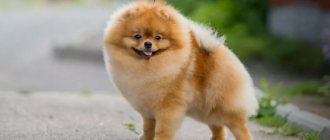Every dog owner wants their pet to live as long as possible.
But in order for the Yorkshire Terrier to live a long and happy life, its owner must take proper care of it and monitor its health.
If the pet has already reached a respectable age, then it needs special care, which will allow the Yorkie to prolong its life as much as possible.
Yorkshire Terriers are lively and active dogs.
Moreover, they remain so until old age.
Breed Features
Yorkies, or Yorkshire terriers, are a miniature breed of dog originally bred to hunt rats and other small rodents. Today they are not used for working purposes, but are actively kept as pets. By adulthood, the dog's weight should vary from 2.3 to 3.2 kg; due to their fast metabolism, they are not prone to weight gain.
By modern standards, Yorkies are a long-haired breed. Their fur should fall straight down to the sides, with a possible parting from the nose to the tail. The yellow-brown coat is similar to human hair, rarely falls out and requires regular care and washing. Despite the decorative appearance, the dog should have a well-developed body, straight and graceful posture. The paws are straight and evenly covered with hair. The hind limbs should be almost at right angles. Until recently, the tail was docked; since 2009, this has not been a prerequisite for participation in the exhibition.
Size classification
You may come across advertisements for a mini or maxi Yorkshire puppy for sale. Such a distinction in size will not come as a surprise only in Russia. Throughout the rest of the world, there are uniform standards and no mini or maxi simply exist. They are trying to sell you a dog, which according to standards should be considered defective.
As for growth, there are no restrictions, but in fact there is not much variation among different individuals. But in terms of weight, the minimum acceptable limit is two kilograms, three hundred grams. The maximum permissible limit is three kilograms and one hundred grams. Dogs that do not fit within the established limits simply do not take part in breeding and exhibitions. The tiniest female Yorkshire, named Sylvia, lived only two years. She was 6.3 centimeters tall at the withers and weighed only one hundred and thirteen grams.
Baby face
In recent years, a variety of Yorkshire terrier called the baby face has gained great popularity. Their feature is a shortened muzzle and enlarged eyes, due to which a childish expression is achieved. With such a structure, the dog does not meet canine standards and is the reason for refusal to participate in exhibitions. In addition, baby-face Yorkies are prone to chronic conjunctivitis, breathing problems and snoring - the reason for this pathology is the structural features of the skull.
Diseases
Each breed is prone to certain diseases. Yorkshire terriers are no exception in this regard. Alas, they cannot boast of excellent health.
Teeth are a problem for Yorkies from an early age. Puppies are sometimes characterized by false polydentia. With it, baby teeth fall out with a delay and grow in two rows with permanent ones, which subsequently leads to problems with bite and tartar.
The increased sensitivity of Yorkies often leads to ear diseases. A small draft is enough for the dog to do this. Therefore, they should be dressed warmly for walks in cool weather, and the coat should be dried after getting wet. There are also frequent cases of ear mites infestation. This disease is much more difficult for small dogs than for their larger counterparts.
Character
Yorkies retain the qualities of a true terrier - they are brave, inquisitive and active. They get along well with people and other animals and respond quickly to training. Yorkshire Terriers need attention, it is important for them to receive the owner's approval and play. They feel the mood of others and are able to adapt to it. To maintain health and increase life expectancy, high activity is a prerequisite for keeping Yorkies - games and walks in the open air are recommended.
https://youtu.be/zfsX1edCvqE
Standard
There are standards that apply to all varieties of Yorkies:
- the dog's growth is not limited,
- weight is limited to three kilograms and one hundred grams, as the maximum possible,
- The wool should fall down in even threads. Fluffiness, wavyness, curliness,
- the color can be described as steel-blue. The fur on the chest and muzzle is light brown. Some varieties may have different colors. Newly born babies are black in color
- the tail is located low, at the level of the spine. In some countries, it is forbidden to dock a Yorkie's tail; then it is left at its natural length,
- the ears act as small, standing triangles.
How many years do Yorkies live?
The average life expectancy of Yorkshire terriers is 12-15 years ; in history there are cases when dogs lived up to 18-20 years. It is believed that girls can live 1-1.5 years longer than boys, which is due to the physiological characteristics of their body.
Yorkies are a hardy and healthy breed. With proper care and proper nutrition, they can live a long and happy life. Unlike other breeds, they have few hereditary diseases, and deaths are more likely to occur due to injuries and similar causes, which is due to their size. The life expectancy of Mini Yorkies and babyfaces is lower than that of classic Yorkshire terriers.
By human standards
How long do Alabai live at home?
Scientists cannot say with one hundred percent certainty how dog age is calculated, especially for small breeds. In recent years, it has become common to count the first year of life as 14 human years, the second year as 10 years, and the subsequent years as approximately 6 years.
You can calculate how many years Yorkies live by human standards using the table:
| Dog age | Appropriate age of person |
| 1 month | 6 months |
| 2 months | 1 year 2 months |
| 3 months | 2 years |
| 4 months | 3 |
| 5 months | 4 years |
| 6 months | 5 years |
| 7 months | 7 |
| 8 months | 9 |
| 9 months | 10 |
| 10 months | 11 |
| 11 months | 13 |
| 1 year | 14 l |
| 2 | 24 years |
| 3 | 30 years |
| 4 | 36 |
| 5 years | 42 years |
| 6 | 47 years old |
| 7 years | 52 years old |
| 8 | 57 years old |
| 9 | 62 years old |
| 10 | 67 years old |
| 11 | 72 years old |
| 12 | 77 years old |
| 13 | 81 years old |
| 14 years | 85 years old |
But 20 dog years is already approximately 97 human years. But these indicators are approximate, since life expectancy is influenced by environmental factors: nutrition, the presence of diseases, heredity, living conditions.
Elderly Yorkshire
Main causes of death
The main causes of death of Yorkie puppies are infectious diseases (parvovirus, distemper, leptospirosis), so it is important to vaccinate in a timely manner and follow the rules for the first walk of the puppy. In addition, at a young age, dogs of this breed often die due to injuries and damage - this is due to their small size. The causes of death in adult Yorkies are:
- Oncological diseases . Dog cancer is a serious disease that requires a responsible approach from the owner and timely treatment. Yorkies are most often diagnosed with lymphoma, mammary cancer and sarcoma. It is believed that with early therapy, the length and quality of life of a pet can be significantly increased.
- Respiratory diseases . Diseases of the respiratory system occur in both puppies and adult dogs. Yorkies over 7 years of age are especially susceptible to these problems, as their lungs become less resistant to infections and toxins. The main causes of death in this group: tracheal collapse, pulmonary fibrosis.
- Injuries . One of the most common causes of death in puppies and adults. Yorkies regularly die from severe injuries to the head due to a fall from a height, a car accident, or the owner's carelessness (reasons: the dog was stepped on or knocked down the stairs). Deaths from injuries, unlike diseases, are much easier to avoid.
- Congenital pathologies . Due to the high popularity of the breed, more and more puppies are being born with developmental defects. These may include body defects, chronic liver or kidney diseases, and epilepsy. That is why it is important to be careful when choosing a breeder and carefully inspect the puppy before purchasing.
The quality and life expectancy of a dog largely depends on proper care, living conditions and genetic characteristics. That is why it is important for every owner to know how to provide their pet with everything necessary and the basic rules of first aid. You need to be especially careful if the following symptoms appear:
- weakness and refusal of activity;
- attacks of vomiting, diarrhea;
- increased thirst, frequent urination;
- unusual behavior;
- presence of mechanical damage on the body;
- seizures, loss of consciousness and convulsions.
If you notice any of these signs, you should contact your veterinarian as soon as possible. Timely diagnosis of the cause and early treatment significantly increase the dog’s chances of recovery.
Symptoms of the disease
Knowing the character and habits of the breed, a person must constantly monitor the pet. At the first suspicious changes, you should contact your veterinarian. Signs of the disease are as follows:
- the dog stops playing and having fun, while constantly lying down;
- breathing becomes heavy;
- nose dry, hot;
- no appetite;
- loses weight.
- The fur is not shiny and looks matted.
This breed is characterized by excessive activity. This gives her strength, normalizes her health, keeps her body in good shape, strengthens her muscles, heart, and bone apparatus. Another factor that will prevent your Yorkie from getting sick is the constant presence of the owner. If the dog is often left alone for a long time, this will significantly shorten the years of existence.
To protect the animal from unwanted illnesses, it is necessary to ensure that it does not get close to huge dogs. The likelihood of this is high, since he is very courageous, brave and, in defense of his owner, will rush at any large, even stray dog, from which he may suffer.
How to extend a dog's life
There are many ways you can increase your Yorkie's lifespan. Dogs require quality care and attention from the first days of life, so from puppyhood you should take a competent approach to keeping your pet. Useful tips:
- Vaccination . Infectious diseases are one of the main causes of death in dogs, so it is important to get all necessary vaccinations in a timely manner. In addition, you should remember that puppies cannot go outside until scheduled vaccination. Repeated procedures are carried out every year.
- Prevention of injuries . In an apartment where a Yorkshire Terrier lives, it is important to ensure the dog’s safety. All family members should be attentive and remember that there may be a pet underfoot. If there are stairs, all large spans must be secured with special devices. Be sure to teach your dog commands so that you can control its behavior on the street.
- Oral hygiene. Yorkies must have their teeth brushed regularly - the procedure removes tartar formation and also removes excess plaque. In advanced cases, pathogenic microorganisms accumulate in the oral cavity, causing the development of many diseases.
- Diet . Food has a huge impact on a dog's health and appearance. It is important to correctly prepare a regular diet, taking into account the characteristics of your Yorkie. It is best to prefer ready-made food that contains all the necessary vitamins, micro- and macroelements.
- Regular activity . Physical activity combined with diet is extremely beneficial for a dog's health. Since terriers were originally bred for hunting, they love active games and exploring the area. Walks should be carried out less than 2 times a day - in the morning and in the evening.
- Taking into account age characteristics. Older dogs require special attention and approach. For them, you need to select proper nutrition, reduce the time and activity of walking. After 7 years of age, the Yorkshire Terrier needs to be seen by a veterinarian at least twice a year.
If you do not plan to use your dog for reproduction, sterilization is recommended. This operation allows you to increase life expectancy and reduce the risk of diseases of the reproductive system. The procedure can be performed as early as 6 months without harm to health. Regardless of the age and condition of the dog, it is necessary to regularly visit the veterinarian for a preventive examination.
Developmental defects
Deviations from the parameters are considered a disadvantage for the dog. Disqualification from exhibitions or exclusion from participation:
- Cryptorchid is the non-descent of the testicles into the scrotum in male dogs.
- Overshot or undershot, any other defect of the bite and jaw.
- Not erect and large ears.
- Color mismatch.
- Health problems, the bitch is in heat, bad coat, bad behavior in the ring.
Briefly about the main thing
- The Yorkshire Terrier is a miniature dog that is often kept as a pet. Characteristic features of the breed are light weight, long hair without undercoat, and a playful character.
- Yorkies live on average 12-15 years. The duration is influenced by hereditary characteristics and conditions of detention.
- The main causes of death for Yorkies are injuries, respiratory and infectious diseases, and cancer.
- To prolong life, it is important to choose the right food, take regular walks and regularly visit the veterinarian. It is important to get vaccinated on time and, if necessary, sterilize.
How long did your Yorkshire Terrier live? Share your impressions of keeping this amazing breed in the comments.
Factors influencing life expectancy
All factors in the duration of a dog's eyelid, including Yorkshire terriers, are of a purely individual nature. A pet may die earlier, during puppyhood, as a result of injuries or infection. So how long do standard Yorkshire terriers live if they don’t have:
- congenital diseases;
- neck injury (caused by the collar), leading to collapse of the trachea;
- oncology.
With proper care and regular visits to the veterinarian, such animals can live for a very long time. The most famous long-living Yorkie, Jack, lived to be 25 years old!
Advantages and disadvantages
- Pros:
- tiny size allows you to keep Yorkies in cramped apartments and take them with you almost everywhere;
- does not cause allergies due to the special coat;
- aesthetic appearance that can be embellished to your liking;
- insightful mind and good learning ability;
- no need for walking twice a day, as you can train the dog to use the litter tray;
- friendliness and sociability of the dog.
- Minuses:
- troublesome care, especially for wool;
- high cost of purchase and maintenance;
- the need for a strict diet;
- Not very good health of dogs.
Intelligence
Terriers are quite intelligent dogs and are easy to train. The process of remembering and following commands is usually easy and enjoyable for the pet. But it is important to start instilling in him the rules of behavior from an early age, literally from the moment he appears in the house. You can begin training directly after the puppy reaches 6 months of age. The only important condition for productive training is not to yell at the dog or show aggression. Such actions can injure the animal and then it will either be aggressive or cowardly.
Choosing a puppy
To choose a good purebred Yorkie, you need to have a general understanding of the breed, character and physical characteristics of the dog. And also follow some tips
:
- Ask a lot of questions. Find out the puppy's pedigree.
- Yorkies have a hard time being separated, so take a very young puppy.
- Visit a nursery, or better yet several. In addition to the puppies themselves, pay attention to what they eat and what dishes they use - everything should be clean. Inspect the enclosures, they should not be overcrowded (maximum 2 Yorkies).
- Pay attention to the puppy's appearance. He should be clean, active, playful, without rashes or wounds, and have an excellent appetite. The eyes should be black and shiny, in no case protruding. The ears should have a V-shaped set.
- You must have a document with the name of the vaccinations performed and their dates.
- A puppy passport is required.
Puppies are black at birth
History of the origin of the Yorkshire Terrier
The breed was developed in the British Isles. The country of origin is England, and specifically the county of Yorkshire. Its ancestors were small dogs with a hardy character and tenacious jaws - Scottish terriers. They were brought to Yorkshire by workers from Scotland who arrived to work in the mid-19th century.
It is not known exactly which of the many breeds of Scottish terriers took part in the development of the Yorkie. Presumably, one of the ancestors of the breed were Waterside Terriers, which protected peasant houses from rodents.
Interesting fact: peasants bred miniature terriers, since they were forbidden to keep large dogs in order to avoid poaching on the lands of the lords. The appearance of Yorkies has features of the Skye Terrier, Cairo Terrier, Manchester Terrier, Paisley Terrier, and they may owe their silky coat to the Maltese.
The name of the new terrier breed was coined in 1874, and the Yorkshire terrier was officially declared an independent breed in 1886 by the English Kennel Club. The breed standard, which is still relevant today, was adopted in 1898, although they began to be shown at exhibitions already in 1861 under the name “Hairy Scottish Terriers.” The heyday of the Yorkie's fame in Britain came during the reign of Queen Victoria, who adored dogs and instilled the custom of having pets among the ladies of high society.
In the USA, the American Kennel Club registered the first Yorkie in 1885, and a hundred years later in Germany, a new breed was developed from the Yorkshire terrier - the Biewer Terrier, which differed from the Yorkies in its black and white coat and was initially exhibited under the name "black and white Yorkshire terrier" .
The Yorkshire Terrier owes its appearance in Russia to the ballerina Lepeshinskaya - she received a puppy as a gift in 1971. The first Yorkie breeder registered a kennel in 1991 in Moscow's Mytishchi, and today there are more than 75 of them.
In the 21st century, the trend for Yorkshire terriers continues. They are among the ten most common breeds in the world, and in the United States, according to the American Kennel Club, Yorkies from 2006 to 2008. ranked second in popularity.











